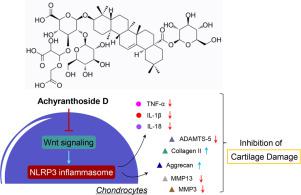Phytomedicine ( IF 6.7 ) Pub Date : 2023-01-11 , DOI: 10.1016/j.phymed.2023.154663 Wenpeng Xie 1 , Shangfeng Qi 1 , Luming Dou 2 , Lei Wang 3 , Xiangpeng Wang 1 , Rongxiu Bi 1 , Nianhu Li 1 , Yongkui Zhang 1

|
Background
Achyranthes bidentata Blume (A. bidentata) is a common Chinese herb used to treat osteoarthritis (OA). Achyranthoside D (Ach-D) is a glucuronide saponin isolated from A. bidentata.
Purpose
To assess the mechanisms of action of Ach-D and its effects on OA.
Methods
The effects of Ach-D were evaluated in rats underwent anterior cruciate ligament transection (ACLT) with medial meniscectomy (MMx) and in interleukin (IL)-1β-induced chondrocytes. Histological changes in rat cartilage tissues were detected using Safranin O-Fast green and haematoxylin-eosin staining. Immunohistochemical staining, qRT-PCR, ELISA, immunoblotting, and immunofluorescence were conducted to examine cartilage degeneration-related and inflammation-related factor expression. CCK-8, LDH assay, and EdU staining were performed to detect chondrocyte death.
Results
Ach-D dose-dependently reduced the Osteoarthritis Research Society International (OARSI) scores, alleviated cartilage injury, and decreased the serum concentrations of CTX-II and COMP in ACLT-MMx models. Ach-D increased the expression levels of collagen II and aggrecan and decreased the levels of cartilage degeneration-related proteins, ADAMTS-5, MMP13, and MMP3, in rat cartilage tissues. Additionally, nod-like receptor protein 3 (NLRP3)-related inflammation was reduced by Ach-D, as shown by the significantly inhibited expression levels of NLRP3, ASC, GSDMD, IL-6, TNF-α, IL-1β, and IL-18 in rat cartilage tissues. In primary rat chondrocytes, Ach-D protected against IL-1β-induced viability loss and LDH release. Wnt3a is the target protein of Ach-D. Mechanistically, Ach-D alleviated OA by inhibiting Wnt signalling.
Conclusion
ACH-D may reduce inflammation and cartilage degeneration by inhibiting the Wnt signalling pathway, thereby reducing OA.
中文翻译:

牛膝苷 D 通过靶向调节 Wnt3a 减轻骨关节炎中的软骨细胞丢失和炎症
背景
怀牛膝 ( A. bidentata ) 是一种常见的中草药,用于治疗骨关节炎 (OA)。Achyranthoside D (Ach-D) 是一种从A. bidentata中分离出来的葡糖苷酸皂苷。
目的
评估 Ach-D 的作用机制及其对 OA 的影响。
方法
在接受前交叉韧带横断术 (ACLT) 和内侧半月板切除术 (MMx) 的大鼠和白细胞介素 (IL)-1β 诱导的软骨细胞中评估了 Ach-D 的作用。使用 Safranin O-Fast green 和苏木精-伊红染色检测大鼠软骨组织的组织学变化。进行免疫组织化学染色、qRT-PCR、ELISA、免疫印迹和免疫荧光检测软骨退化相关和炎症相关因子的表达。进行 CCK-8、LDH 测定和 EdU 染色以检测软骨细胞死亡。
结果
Ach-D 剂量依赖性地降低了国际骨关节炎研究协会 (OARSI) 评分,减轻了软骨损伤,并降低了 ACLT-MMx 模型中 CTX-II 和 COMP 的血清浓度。Ach-D 增加了大鼠软骨组织中胶原蛋白 II 和聚集蛋白聚糖的表达水平,并降低了软骨退化相关蛋白 ADAMTS-5、MMP13 和 MMP3 的水平。此外,Ach-D 减少了点头样受体蛋白 3 (NLRP3) 相关的炎症,如 NLRP3、ASC、GSDMD、IL-6、TNF-α、IL-1β 和 IL 的显着抑制表达水平所示-18 在大鼠软骨组织中。在原代大鼠软骨细胞中,Ach-D 可防止 IL-1β 诱导的活力丧失和 LDH 释放。Wnt3a 是 Ach-D 的靶蛋白。从机制上讲,Ach-D 通过抑制 Wnt 信号来减轻 OA。
结论
ACH-D 可通过抑制 Wnt 信号通路减少炎症和软骨退化,从而减少 OA。































 京公网安备 11010802027423号
京公网安备 11010802027423号